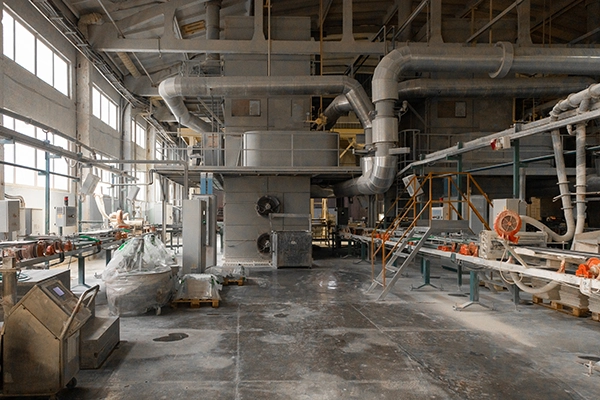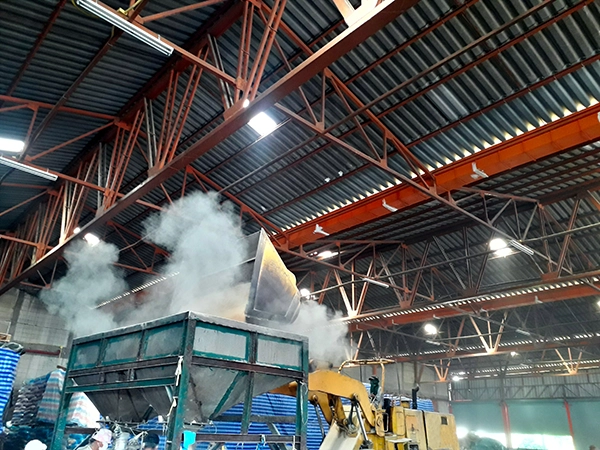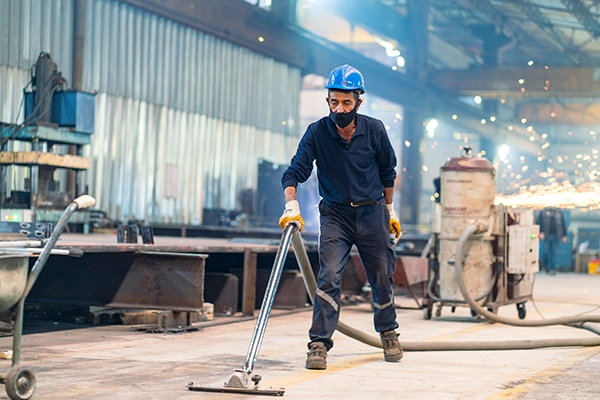Process Dust vs. Nuisance Dust: What’s the Difference?
In industrial environments, dust isn’t just an annoyance—it’s a potential health and safety hazard. But not all dust is created equal. Understanding the difference between process dust and nuisance dust is key to effective dust control, regulatory compliance, and maintaining a safe workplace. In this blog, we’ll break down what sets these two types of dust apart, the risks they pose, and the best strategies for managing them.
What Is Process Dust?

Process dust is the dust generated directly from industrial operations and manufacturing activities. It’s a byproduct of specific processes such as cutting, grinding, sanding, polishing, crushing or material handling. Unlike general background dust, process dust is tied to the core activities happening on the production floor, often produced in large volumes and concentrated in specific areas where the work occurs.
The composition of process dust varies widely depending on the materials being used. In a woodworking facility, process dust might consist of fine sawdust and wood particles. In metal fabrication, it could be metal shavings, grinding dust or welding fumes. In the pharmaceutical manufacturing or food processing industries, it often includes fine powders from ingredients or chemical compounds. What all these forms of process dust have in common is that they are created as an inherent part of getting the job done.
Hazards of Process Dust
While process dust might seem like just another part of the manufacturing landscape, it can pose serious health and safety risks. It can also lead to product quality problems and compliance issues. Hazards associated with process dust can include:
- Human Health Hazards: Fine dust particles from industrial processes can become airborne and be inhaled, leading to respiratory issues such as chronic bronchitis, silicosis or other long-term health conditions. Certain process dusts are also toxic or carcinogenic, leading to health problems including cancer, neurological problems, liver and kidney damage, or developmental and reproductive effects.
- Combustion Risk: Most types of process dust are classified as combustible dust, meaning they can ignite and cause fires or catastrophic dust explosions under the right conditions. This includes all organic dust types (e.g., wood, paper, food, many chemicals and pharmaceutical) and many metal dusts.
- Cross-contamination: Uncontrolled process dust may lead to product quality and safety concerns, especially in sensitive applications such as food and pharmaceutical production, electronics, or battery manufacturing.
- Equipment Damage: Dust buildup inside machinery can cause overheating, mechanical wear, and equipment failure, leading to costly downtime and maintenance issues.
- Environmental Emissions: Process dust can escape into the environment, contributing to air pollution, regulatory compliance issues, and potential harm to local ecosystems.
- Regulatory Compliance Risks: Failure to properly manage process dust can result in violations of workplace safety and environmental regulations, leading to fines, legal liability, and reputational damage.
Regulations for Process Dusts
Process dust is subject to stricter regulations than nuisance dust because it often poses greater risks to health, safety, and the environment. Regulatory agencies set strict guidelines to control dust-related hazards in the workplace, including exposure limits, safety protocols, and compliance standards. Failing to meet these requirements can lead to hefty fines, legal liabilities, and increased risk of workplace incidents. Depending on the type of process dust and the specific hazards, businesses may be subject to regulations or standards from several agencies, including:
- U.S. Occupational Safety and Health Administration (OSHA): Enforces workplace safety regulations for process dust through the General Duty Clause and sets permissible exposure limits (PELs) for hazardous process dusts like welding fumes, respirable crystalline silica, asbestos, lead, and other potentially toxic substances to protect worker health.
- National Fire Protection Association (NFPA): Provides standards for controlling combustible dust hazards and conducting a dust hazard analysis (DHA). Combustible dust standards, including standards for dust control and dust collection system design, are now consolidated under NFPA 660. While not themselves legally enforceable, these standards form the basis for regulation and enforcement by OSHA and other agencies.
- Environmental Protection Agency (EPA): Regulates dust emissions under the Clean Air Act, focusing on particulate matter (PM) that impacts outdoor air quality and can harm both human health and the environment.
- Food and Drug Administration (FDA): 21 CFR Part 110 (Food Production) and 21 CFR Part 211 (Pharmaceuticals)—both part of FDA Current Good Manufacturing Practices (cGMP)—set standards and regulations for controlling both process and nuisance dust to prevent product contamination and ensure consumer safety.
- Local and State Regulations: Many states and municipalities have additional requirements for air quality, environmental protection, and workplace safety that go beyond federal standards.
To stay compliant, companies may need to conduct regular dust hazard analyses, implement effective dust control systems, provide employee training, and continuously monitor dust levels in the workplace.
What Is Nuisance Dust?

Nuisance dust, sometimes referred to as inert dust or ambient dust, is the type of dust that accumulates from general activities within an industrial or commercial environment. Unlike process dust, which is directly generated by specific manufacturing operations, nuisance dust comes from background sources—such as material handling, equipment movement, foot traffic and natural air circulation. Nuisance dust is often generated during package handling, packaging and unpacking boxes, and other material handling applications not directly tied to production. Dust from these activities, along with general environmental dust, often settles on floors, surfaces, and equipment, creating housekeeping challenges more than immediate health or safety threats.
Nuisance dust typically consists of particles that are chemically stable, meaning they don’t react with other substances or present significant toxic risks under normal conditions. This is why it’s sometimes called inert dust. Common examples include dust from soil, sand, cement, or non-toxic industrial materials.
Hazards of Nuisance Dust
Despite being labeled “nuisance,” this type of dust can still pose hazards, especially when it accumulates over time. Inhalation of fine dust particles can cause respiratory irritation, and excessive buildup can lead to equipment malfunctions and slippery surfaces, creating slip-and-fall hazards. Hazards associated with nuisance dust vary with dust concentration levels and characteristics and may include:
- Respiratory Irritation: Inhalation of fine dust particles can cause coughing, sneezing, throat irritation, and, with prolonged exposure, may contribute to chronic respiratory conditions.
- Slip-and-Fall Hazards: Accumulated dust on floors can create slippery surfaces, increasing the risk of workplace accidents and injuries.
- Reduced Air Quality: High concentrations of airborne dust can decrease indoor air quality, leading to discomfort and health issues for workers, especially those with pre-existing respiratory conditions.
- Equipment Malfunctions: Dust buildup on machinery, electrical components, and ventilation systems can cause overheating, reduced efficiency, and mechanical failures.
- Fire Risk: While often less combustible than process dust, certain nuisance dusts can still pose a fire hazard when accumulated near heat sources or electrical equipment.
- Secondary Explosion Risk: In environments where combustible dust is present, accumulated nuisance dust can contribute to secondary explosions following an initial dust-related incident.
- Product Contamination: In sensitive environments like food processing, pharmaceuticals, or clean manufacturing, dust accumulation can compromise product quality and safety.
Regulations for Nuisance Dust
While nuisance dust is generally considered less hazardous than process dust, it’s not without regulatory oversight. OSHA’s housekeeping standards address the need to control dust accumulation in workplaces, and companies are expected to maintain clean environments to prevent slip hazards, fire risks, and potential respiratory exposure. Effective nuisance dust control typically involves good housekeeping practices, proper ventilation, and routine inspections to ensure dust doesn’t become a bigger problem over time.
Nuisance dust regulations vary depending on the industry and application; a fabrication shop does not need to maintain the same cleanliness standards as a food processing facility, for example. Specific regulations to consider include:
- OSHA General Duty Clause (Section 5(a)(1)): Requires employers to provide a workplace free from recognized hazards that are likely to cause death or serious physical harm, which includes controlling dust accumulation that could pose safety risks and ensuring reasonable indoor air quality for workers.
- OSHA Standard 1910.22 (Walking-Working Surfaces): Mandates that all walking-working surfaces must be kept clean, orderly, and sanitary to prevent slip-and-fall hazards caused by dust accumulation.
- OSHA Standard 1910.176 (Housekeeping): Requires employers to maintain clean work areas, especially where dust buildup could pose a safety hazard around materials handling and storage.
- OSHA Standard 1910.307 (Hazardous Locations): Addresses housekeeping in areas where dust accumulation could contribute to fire or explosion hazards, even if the dust itself is not highly combustible.
- EPA Clean Air Act (Particulate Matter Standards): Regulates emissions of fine particulate matter (PM10 and PM2.5) from industrial facilities, which can include nuisance dust that becomes airborne and impacts environmental air quality.
- FDA Current Good Manufacturing Practices and USDA Regulations for Food Safety: Manufacturers in the food, pharmaceutical and nutraceutical industries must comply with cGMPs and Food Safety regulations, which require manufacturers to maintain clean facilities to prevent contamination. This includes controlling dust accumulation in processing, packaging, and storage areas.
- ISO 14644 (Cleanroom Standards): Applies to industries like pharmaceuticals, biotechnology, and semiconductor manufacturing, where both process and nuisance dust can compromise product sterility or functionality. This standard sets specific limits on airborne particulate concentrations, requiring advanced HVAC systems, HEPA filtration or better, and controlled environments.
Dust Control Strategies for Process and Nuisance Dust
Effective dust control is essential for maintaining a safe, compliant and efficient work environment. While process dust and nuisance dust differ in their sources and associated risks, they often require overlapping strategies to mitigate hazards. Both types of dust benefit from strong ventilation, regular housekeeping and proper air filtration systems. However, process dust control usually focuses more on capturing dust at the source, while nuisance dust management emphasizes environmental cleanliness and general air quality control.
Dust Control Strategies for Process Dust

Process dust originates directly from industrial activities like cutting, grinding, sanding or material handling. Since it often poses higher risks—such as combustibility, toxicity, or contamination—control strategies typically focus on capturing dust where it’s generated and preventing its spread throughout the facility.
- Source Capture Systems: Where possible, utilize source capture dust collection systems or local exhaust ventilation (LEV) to capture dust at the point of generation before it propagates through the facility. Source capture systems may use process hoods and enclosures (e.g., the Streamline Hood system) or close-capture hood systems (e.g., fume arms, backdraft plenums) to keep process dust out of the breathing zone for employees. Where source capture is not possible or practical, an ambient fume extraction system may be used to remove dust and fumes.
- Dust Collectors: Implement dust collectors with appropriate filtration (e.g., cartridge dust collector filters, HEPA filtration) to handle hazardous or combustible dust. A cartridge dust collector is a good choice for most industrial applications.
- Explosion Protection: In environments with combustible dust, incorporate explosion vents, chemical explosion suppression systems, and isolation valves to reduce explosion and fire risks. An NFPA-compliant deflagration system is required for dust collection systems used for combustible dust.
- Enclosed Processes: Design equipment and workflows to minimize dust release using sealed conveyors, enclosed transfer points, and automated material handling. If handling combustible dust, using NFPA-compliant system design and proper airflow to prevent buildup of dust to dangerous levels within enclosures is essential.
- Personal Protective Equipment (PPE): Provide respirators, protective clothing, and eye protection where process dust exposure cannot be fully eliminated. Remember that under the hierarchy of controls, PPE cannot be a substitute for proper engineering controls such as industrial dust collection and air filtration.
- Routine Maintenance: Regularly inspect and maintain dust control equipment to ensure proper function, prevent system failures, and avoid secondary dust accumulation.
Dust Control Strategies for Nuisance Dust

Nuisance dust comes from background activities, general facility operations, and environmental sources. While less hazardous in many cases, it can still create health, safety, and operational issues if allowed to accumulate. The focus here is on preventing dust buildup and maintaining clean, well-ventilated spaces. Strategies include:
- Housekeeping Programs: Implement regular cleaning schedules using vacuum systems with HEPA filters (avoiding dry sweeping, which can re-suspend dust into the air).
- Air Filtration Systems: Use an ambient air filtration system or an HVAC system with high-efficiency filters to improve indoor air quality and reduce airborne dust concentrations. In environments with high nuisance dust loads, an ambient dust collection system will maintain cleaner air while reducing the load on the HVAC system, which is not designed for control of heavy dust.
- Facility Design Improvements: Seal cracks, gaps, and leaks where dust can accumulate; use smooth, easy-to-clean surfaces; and optimize facility layout for better airflow.
- Dust Suppression Techniques: Apply mist systems, anti-static agents or dust-binding chemicals in areas prone to dust accumulation (common in construction or bulk material handling).
- Traffic and Material Handling Controls: Minimize dust generation from foot traffic and forklifts by using walk-off mats, dust barriers and controlled material handling procedures.
- Employee Training: Educate workers on the importance of dust control, proper cleaning methods, and how to report dust-related hazards.
Bringing It All Together
While process dust requires targeted controls at the source and compliance with strict safety regulations, nuisance dust management relies on good housekeeping and environmental controls to prevent buildup. An effective dust control program addresses both types of dust, combining engineering solutions, administrative controls, and employee engagement to create a safer, cleaner and more productive workplace.
At RoboVent, we specialize in dust control system design tailored to meet the unique challenges of both process and nuisance dust. Whether you need source capture solutions for hazardous process dust or facility-wide air filtration to manage nuisance dust, our advanced dust collection systems are engineered for maximum efficiency, safety, and compliance. From customized system design to ongoing support and maintenance, RoboVent helps you create a cleaner, healthier and more productive work environment.
Contact Us With Your Questions!
SUBSCRIBE TO
BLOG UPDATES









